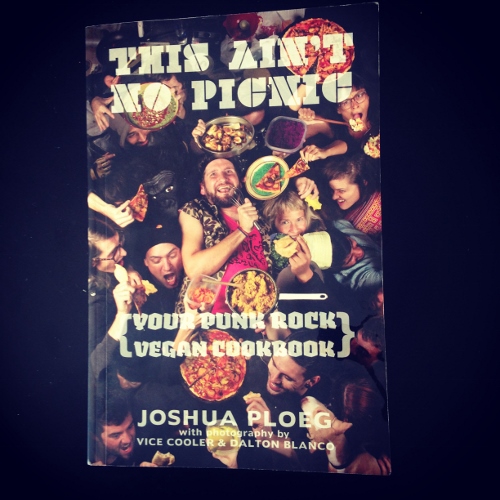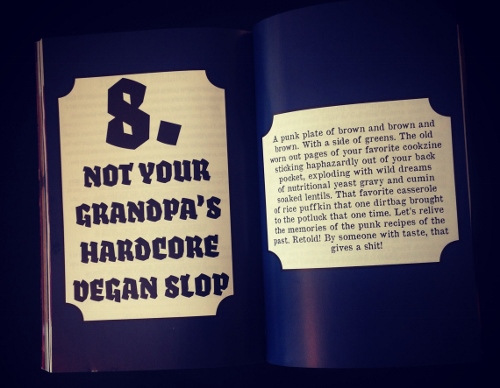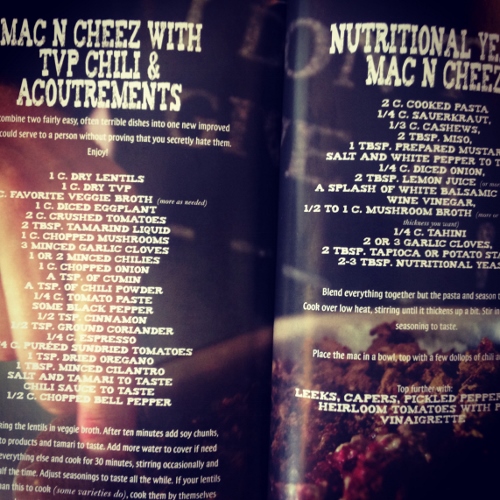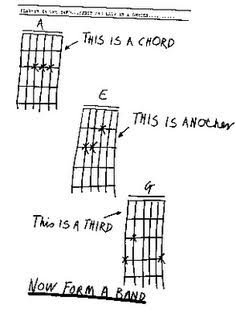Dinner & a Disc: X’s Los Angeles and Punk Night
What happens when you play a seminal punk record and cook vegan food with a teenager
Food Features los angeles“The government doesn’t want you to wear flip flops,” says my son Henry, confident as only a sixteen-year-old can be. I admire his revolt against bourgeois rules of attire, though honestly I am the one who doesn’t want him to wear flip-flops. I think he looks like a frat boy at a Jimmy Buffet concert and furthermore he has a solid mile to walk home from school. But I listen as he goes on to tell me that flip-flops don’t encourage productivity and conformity, which is what the government wants from us.
“You know,” I say, “This is some pretty punk rhetoric.”
“As long as I don’t have to listen to more of those records,” he says. “Or eat more of that food.”
Punk Night was only a few nights ago. And it wasn’t a smash hit.
In fact, here’s a perfect recipe for a strained Sunday family dinner: cook some vegan food for your son, freaky vegan versions of some of his favorites (nutritional yeast mac n’ cheez, textured vegetable protein chili, chocolate cashew “milkshake”) while forcing him to listen to X’s Los Angeles in its entirety. Throw in some stories about when you were sixteen and you and your cool punk friends opened and operated an all-ages club.
It’s all part of my ongoing experiment, Dinner and a Disc, in which I pair an album and a meal. In this case the pairing started with an album. Los Angeles (1980) is a California punk classic, and X were a definitive American punk band. So, I thought, I should pair it with a punk meal. But what’s a punk meal? I know what punk sounds like—it sounds like Los Angeles: nine tight and ferocious songs thrown down by a band that had been perfecting them live for years to raucous moshing audiences at the Whiskey a Go Go. Distinguished by John Doe’s muscular voice, Exene Cervenka’s idiosyncratic harmonies, DJ Bonebrake’s powerful drumming and— especially—Billy Zoom’s astonishingly catchy guitar riffs. The album’s tough lyrics about LA street life are perfectly in tune with the punk slogan, “No Future.”
Ideally these “mock” dishes allow us to enjoy both meanings of the word mock. It is a critique and not just an inferior substitute. Kind of like punk.
But what does punk taste like? How does food fit into the story? If there’s no future, does food even matter?
There hasn’t been much published on food and punk, but I stumbled upon an excellent article, “The Raw and the Rotten: Punk Cuisine” by Dylan Clark. Clark’s piece is a case study of The Black Cat Café, a now-defunct vegetarian restaurant and hangout in Seattle. He approaches that scene through the lens of Claude Levi-Strauss’s “culinary triangle” of raw, cooked, and rotted, and argues that punks gravitate away from the “cooked” category—foods that are processed, branded, and refined—in favor of the “raw”—uncultured, unprocessed, wild—or “rotted”—stolen or pulled out of a dumpster.
I wasn’t prepared to dumpster dive for this meal, but I was intrigued by Clark’s discussion of how the Black Cat Café community equated the meat and dairy industry with capitalism, patriarchy, cruelty, and environmental destruction. Being vegetarian, and especially being vegan, was another way to question authority, but vegetarianism was also something I associated with the 1960s counterculture. And punks hated hippies. Punk was about “no future,” but also about “no past,” driving a wedge between the present moment and the weight of previous rock traditions and expectations.
I hadn’t solved the hippie question, but had the good fortune to discover an actual punk cookbook: Johsua Ploeg’s This Ain’t No Picnic: Your Punk Rock Vegan Cookbook. (Named after a Minutemen song!) The budget layout of Ploeg’s book makes it look more like a zine on the dirty floor of an Olympia record store than a cookbook, and I must admit I was prepared to roll my eyes all the way through it. But I didn’t. I giggled at the gleeful punkness of the recipes—Dashboard Kale Chips, Engine Block Casserole, Zippo S’mores and Old Dumpstered Bagel Bread Pudding. I loved the section of recipes inspired by punk icons, like Refried Bean Pizza for Joey Ramone. Not only is it all good fun, but the recipes suggest that Ploeg has spent a lot of time preparing food, whether on dashboards and engines or in kitchens.

I also instantly related to Ploeg when I read his bio. He writes: “as someone who entered punk culture after punk was already dead…” I became something of a punk in 1982, and it was already dead by then. Even in my small southern Indiana town there was a clear sense that I’d missed the real moment and the older punks in Bloomington called me and my friends “pseudo punks,” which taught me early on that punks tended to police their borders as vigilantly as any mean cheerleader clique. “Besides,” writes Kathleen Hannah in her 1994 zine My Life with Evan Dando, Popstar, “I’m way punker than Juliana Hatfield.” You Weren’t There is the (clearly good-humored) title of the 2009 documentary about the Chicago punk scene. But during the first wave of British punk, everybody was there, punk was wildly popular—the Sex Pistols had a number one single in the UK with “God Save the Queen.” My favorite punk flyer is the one with illustrated tablature of three guitar chords and the message, “This is a chord, this is another, this is a third. Now form a band.” Anybody could be punk.

Punk Night at my house would be small but non-exclusive—the attendees would be me, my husband Jake, and our son Henry. For the menu, I selected dishes from This Ain’t No Picnic’s “Not Your Grandpa’s Hardcore Vegan Slop” chapter. First, there was a chili-topped macaroni dish that sounded safe and crowd-pleasing (“Here we combine two fairly easy, often terrible dishes into one new improved thing you could serve to a person without proving that you secretly hate them”). We finished with a “big sexy milkshake” inspired by the Big Boys’s Randy Turner. I had a lot of pricey shopping to do to get the sauerkraut, cashews, miso, mustard, white pepper, onion, garlic, lemon juice, white balsamic vinegar, mushroom broth, tahini, potato starch, and nutritional yeast I needed for Ploeg’s mac and cheez, and the textured vegetable protein, tamarind liquid, espresso, sundried tomatoes, and mountain of spices and vegetables for the chili. I doubt the dumpster would have been much help to me.
I didn’t mind buying all this stuff, and it wasn’t a foray into the exotic—I’ve been vegan myself for stretches of time, and was strictly macrobiotic for a while. I’ve spent plenty of time on the fringes of food, and I know my nutritional yeast from my textured vegetable protein. I’m not vegan anymore, but I’m a sucker for inventive vegan food and a longtime fan of recipes that try to imitate and stand in for conventional ones. Ideally these “mock” dishes allow us to enjoy both meanings of the word mock: not only is mac and cheez a pretend version of a dish, it is also making fun of “good old” dairy-laden macaroni and cheese. It is a critique and not just an inferior substitute. Kind of like punk, which was rock at the same time that it was rock criticism.
Ploeg’s food delivered in all regards. His cheez sauce, in particular, is luscious and zingy, a mocking improvement on the classic in terms of both flavor and texture. My son did not share my love. “Hey,” he said, after his first bite, “can you make normal macaroni and cheese sometime? The way you make it with the breadcrumbs on top?”
Henry, who had made himself a sandwich, was obviously searching for something nice to say: “I don’t hate this album as much as that Sex Pistols record.”
He wasn’t crazy about Los Angeles either, and spent those twenty-seven minutes picking at his expensive bowl of vegan food, listening to Exene “scream,” and complaining that the record “hurt his neck.” Just as John Doe and Exene wailed through the disturbing rape narrative of “Johnny Hit and Run Pauline,” he asked, “What is this album about?”
“You don’t want to know,” answered Jake.
“What do they believe in?” he asked at another point. I addressed this question falteringly, finally talking about punk’s DIY ethic. I thought it would appeal to him. I told him about Ricky’s Canteena, a short-lived but glorious experiment of my high school years, when a bunch of local punks joined forces one summer with a local slumlord to clear out a junk-filled storage space on top of a Salvation Army store, build a stage, install a sound system, and book punk bands. He didn’t look super impressed. He reminded me that he is spending his summer volunteering at the animal shelter.

It was hurting my son’s neck and sensibilities, but Los Angeles sounded great to me, as raw and modern as ever. I was reminded of my question about punks and hippies as I soaked in the production and groovy keyboard playing of Ray Manzarek, who had himself rocked the Whiskey A Go Go when the Doors played there a couple of decades before. The album even includes a version of the Doors’ “Soul Kitchen.” Los Angeles gives a big conscious nod to its LA lineage, and this marriage of the 60s and the 80s flies in the face of conventional wisdom about the unbridgeable gap between punks and hippies. The first X album managed to land in a sweet spot, with the vitality of British punk and a wild, democratic openness, before punk would entirely splinter into its subgroups of hardcore, oi, etc. In fact the album is downright embracing, finding a sonic space for the 50s too: I mean, Billy Zoom is Gene Vincent.
Our vegan dinner shared this sensibility. The first popular vegetarian restaurants in the US—predecessors of the Black Cat Café—were hippie establishments. Think of Woody Allen in Annie Hall, having lunch in California, ordering “mashed yeast” and looking very uncomfortable. The Sex Pistols probably wouldn’t have cared for that restaurant either. In fact the conversation about food might not have landed on the punk table until the Smiths song “Meat Is Murder” met the ideology of the American straight edge punk movement and gave birth to the vegan punks behind the Black Cat and its ilk. Joshua Ploeg slyly acknowledges his vegetarian lineage by calling his chapter “Not Your Grandpa’s Hardcore Vegan Punk Slop.” Finding his own democratic sweet spot, Ploeg invites everybody to the vegan punk party—instead of dissing grandpa, he takes his crappy veggie chili and makes it new and better.
We made our way to the last song, “The World’s a Mess It’s In My Kiss” and Henry, who had made himself a sandwich, said he liked that song best. He was obviously searching for something nice to say: “I don’t hate this album as much as that Sex Pistols record.”
He added, absentmindedly, “Punk seems so angry.” Jake mentioned Columbine. Sandy Hook. Great, now we’d managed to bring rape and school shootings to the dinner table. It seemed like the right time to make milkshakes. Jake’s point lingered—the world is more of a mess than ever, but are kids allowed to be openly angry anymore, to dress in black and gather above Salvation Army stores? Doing so might invoke suspicion of activity way scarier than slam dancing.
I’m happy to report that the milkshake was brilliant, a complex blend of strawberries, bananas, melted chocolate, coconut cream, cashews, lemon juice, dates, salt, and vanilla. “This is a great punk milkshake,” said Henry, with just a smidge of mockery in his tone. But he inhaled the whole thing. Maybe it’s true, what Barack Obama said about my son’s generation: “They’re better than us.” Is it because they want to be or because they have to be? Henry plans to spend his summer helping dogs. And wearing flip flops. Hippie. But I have to accept the possibility that he is way punker than me.

Freda Love Smith is a drummer and writer whose food memoir, Red Velvet Underground, is forthcoming on Agate. She blogs here. Follow her on Twitter: @fredalovesmith.